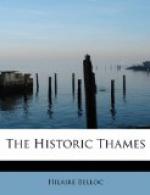To return to the ground we have already briefly covered, and to establish a comparison with Wallingford, the word “haga,” which we saw to be of such doubtful value in the case of Wallingford, is replaced in Oxford by the word “mansio.” The taxable units so enumerated are just over 600, but of these much more than half are set down as untaxable or imperfectly taxable under the epithets “Uasta,” “Uastae.” What that epithet means we do not know. It may mean anything between “out of repair,” “excused from taxation because they do not come up to our new standard of the way in which a house in a borough should be kept up, and because we want to give them time to put themselves in order,” down to the popular acceptation of the word as meaning “ruined,” or even “destroyed.”
We know that at the close of the eleventh century, or indeed at any time before the thirteenth, the small man who lived under his own roof would live in a very low house, and that, space for space of ground area, the cubical contents of these poor dwellings would be less than those of modern slums. On the other hand, we know that the population would live much more in the open air, slept much more huddled, and also that a very considerable proportion—what proportion we cannot say, but probably quite half of a Norman borough—was connected with the huge communal institutions—military, ecclesiastical, and for that matter mercantile, as well—which marked the period. We know that the occupied space stood for very much what is now enclosed by the line of the old walls, and we know that under modern conditions this space, in spite of our great empty public buildings, our sparsely inhabited wealthy houses, and our college gardens, can comfortably hold some 5000 people. We can say, therefore, at a guess, but only at a guess, that the Oxford of the Conquest must have had some 3000 people in it at the very least, and can hardly have had 10,000 at the most. These are wide limits, but anyone who shall pretend to make them narrower is imposing upon his readers with an appearance of positive knowledge which is the charlatanism of the colleges, and pretends to exact knowledge where he possesses nothing but the vague basis of antiquarian conjecture.
It is sufficiently clear (and the reading of any of our most positive modern authorities upon Domesday will make it clearer) that no sort of statistical exactitude can be arrived at for the population of the boroughs in the early Middle Ages. But when we consider that Reading is certainly underestimated, and when we consider the detail in which we are informed of Old Windsor, Wallingford, and Oxford, with the neglect of Abingdon, Lechlade, Cricklade, and Dorchester, one can roughly say that the Thames above London possessed in Staines, Windsor, Cookham, probably Henley, perhaps Bensington, Dorchester, Eynsham, and possibly Buscot, large villages varying from some hundreds in population to a little over 1000, not defended, not reckoned as towns, and agricultural in character. To these we may add Chertsey, Ealing, and a few others whose proximity to London makes it difficult for us to judge except in the vaguest way their true importance.




